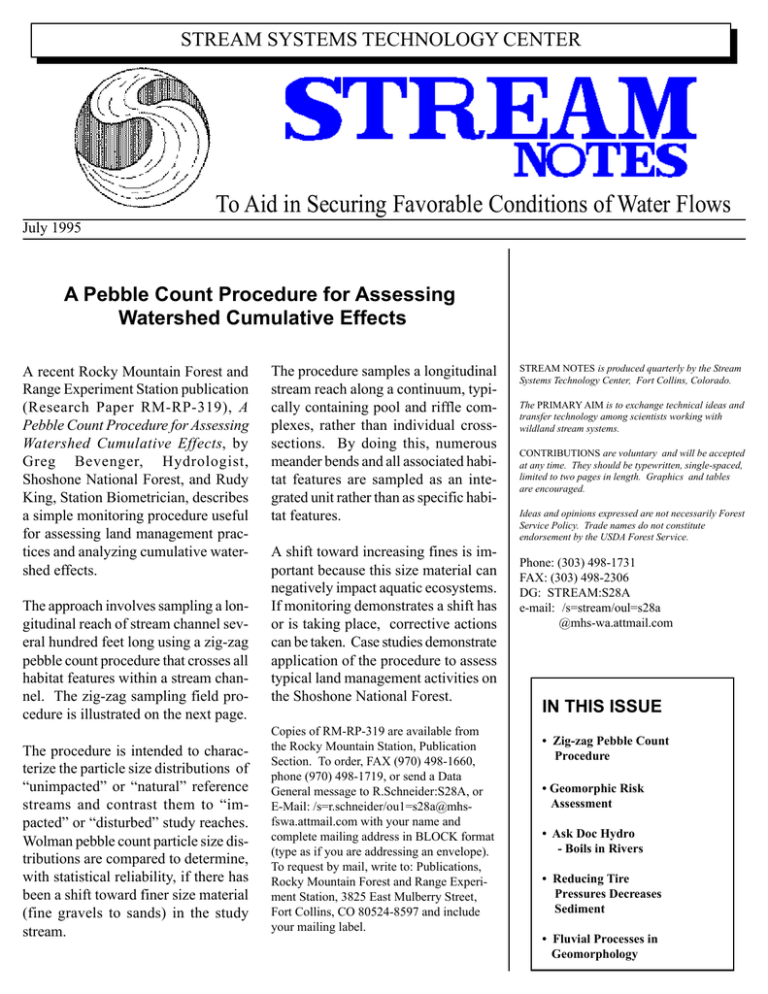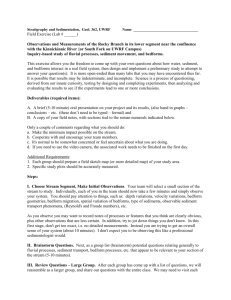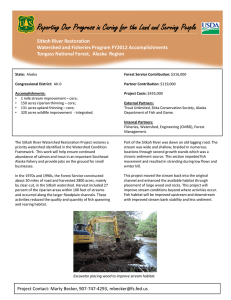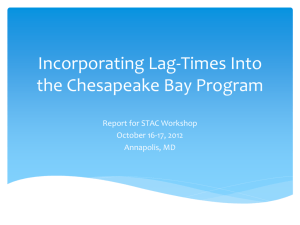Document 10550810
advertisement

STREAM SYSTEMS TECHNOLOGY CENTER To Aid in Securing Favorable Conditions of Water Flows July 1995 A Pebble Count Procedure for Assessing Watershed Cumulative Effects A recent Rocky Mountain Forest and Range Experiment Station publication (Research Paper RM-RP-319), A Pebble Count Procedure for Assessing Watershed Cumulative Effects, by Greg Bevenger, Hydrologist, Shoshone National Forest, and Rudy King, Station Biometrician, describes a simple monitoring procedure useful for assessing land management prac­ tices and analyzing cumulative water­ shed effects. The approach involves sampling a lon­ gitudinal reach of stream channel sev­ eral hundred feet long using a zig-zag pebble count procedure that crosses all habitat features within a stream chan­ nel. The zig-zag sampling field pro­ cedure is illustrated on the next page. The procedure is intended to charac­ terize the particle size distributions of “unimpacted” or “natural” reference streams and contrast them to “im­ pacted” or “disturbed” study reaches. Wolman pebble count particle size dis­ tributions are compared to determine, with statistical reliability, if there has been a shift toward finer size material (fine gravels to sands) in the study stream. The procedure samples a longitudinal stream reach along a continuum, typi­ cally containing pool and riffle com­ plexes, rather than individual crosssections. By doing this, numerous meander bends and all associated habi­ tat features are sampled as an inte­ grated unit rather than as specific habi­ tat features. A shift toward increasing fines is im­ portant because this size material can negatively impact aquatic ecosystems. If monitoring demonstrates a shift has or is taking place, corrective actions can be taken. Case studies demonstrate application of the procedure to assess typical land management activities on the Shoshone National Forest. Copies of RM-RP-319 are available from the Rocky Mountain Station, Publication Section. To order, FAX (970) 498-1660, phone (970) 498-1719, or send a Data General message to R.Schneider:S28A, or E-Mail: /s=r.schneider/ou1=s28a@mhs­ fswa.attmail.com with your name and complete mailing address in BLOCK format (type as if you are addressing an envelope). To request by mail, write to: Publications, Rocky Mountain Forest and Range Experi­ ment Station, 3825 East Mulberry Street, Fort Collins, CO 80524-8597 and include your mailing label. STREAM NOTES is produced quarterly by the Stream Systems Technology Center, Fort Collins, Colorado. The PRIMARY AIM is to exchange technical ideas and transfer technology among scientists working with wildland stream systems. CONTRIBUTIONS are voluntary and will be accepted at any time. They should be typewritten, single-spaced, limited to two pages in length. Graphics and tables are encouraged. Ideas and opinions expressed are not necessarily Forest Service Policy. Trade names do not constitute endorsement by the USDA Forest Service. Phone: (303) 498-1731 FAX: (303) 498-2306 DG: STREAM:S28A e-mail: /s=stream/oul=s28a @mhs-wa.attmail.com IN THIS ISSUE • Zig-zag Pebble Count Procedure • Geomorphic Risk Assessment • Ask Doc Hydro - Boils in Rivers • Reducing Tire Pressures Decreases Sediment • Fluvial Processes in Geomorphology Zig-zag pebble count procedure After Bevenger and King, 1995 STREAM SYSTEMS TECHNOLOGY CENTER A Geomorphic Risk Assessment of Potential Fish Habitat Impacts from Forest Management in Southeast Alaska T. W. Geier, Ph.D., Hydrologist and W.D. Loggy, Soil Scientist USDA Forest Service, Tongass National Forest, Ketchikan, AK cess uses a Geographical Information System (GIS), topo­ graphic maps, a regional hydrologic model, and existing field data to estimate sediment risk. Applications include developing management and monitoring strategies, identi­ fying high-risk areas, and setting field work priorities. Timber harvest, road-building and other forestry practices must be properly managed to avoid sedimentation of fish habitat. In mountainous terrain, however, detailed sediment analysis is often constrained by the logistics and cost of sampling. To improve management decision-making for remote, ungaged watersheds, Geier and Loggy (1995) de­ veloped a watershed-level analysis for identifying impor­ tant areas of sediment transport and deposition. The pro­ Procedures were developed on a pilot 4th-order watershed near Ketchikan, Alaska (fig. 1). Tributary sub-basins and mainstem reaches delineated on 5 inch = 1 mile topographic maps were the primary units of analysis. For each unit, two parallel series of indices were developed (transport and depositional) based on quantitative measures of watershed morphology, discharge, and potential sediment sources. Figure 1 STREAM SYSTEMS TECHNOLOGY CENTER Watershed Morphology. The basic transport index uses the product of drainage density (stream length/area) and relief ratio (basin relief/length) as a measure of basin en­ ergy and transport efficiency (Simons et. al., 1980). The depositional index uses the drainage density of low-gradi­ ent streams (< 2%) to identify and rate depositional areas. Aerial photographs, field data, or a stream classification system (e.g., Rosgen (1994), USFS (1992)) may be used to identify depositional streams. increment associated with source areas. Final depositional ratings (FHHsdh) for the pilot watershed are shown in figure 3 (next page). The highest score was observed in reach R4, in which numerous floodplain channels feed a large, some­ what braided, low-gradient mainstem. Discharge. The two geomorphic indices are adjusted for discharge using a ratio based on the estimated bankfull flow (i.e., 2-year flood), which is highly correlated with channel formation (Dunne and Leopold 1978). The dischargeweighted indices are called the Sediment Transfer Hazard (STH) and Sediment Deposition Hazard (SDH). Developing Management Strategies. The FHH assessment can be used to estimate risk associated with harvest areas and roads early in the planning process. Cumulative FHH scores for the watershed can be reduced by concentrating harvest activities in low-risk areas. Sediment Sources. A final Fish Habitat Hazard (FHH) rat­ ing is calculated from the STH and SDH by incorporating potential sediment sources. Four major categories are in­ cluded: natural sources, harvest units, roads and landslides. Final transport ratings (FHHsth) for the pilot watershed are shown in figure 2. In general, higher scores are observed for tributary sub-basins and those reaches with a relatively high gradient and discharge. Shaded areas represent the Scores can be evaluated individually, combined into a cu­ mulative watershed score, or disaggregated into components for analysis. Applications include: Comparing Management Alternatives. FHH scores can be calculated for several management alternatives and com­ pared with projected timber volumes to improve decisionmaking. Implementing Best Management Practices (BMPs). FHH scores can be used to identify areas for special BMP imple­ mentation. For example, sub-basins S4, S5, S8 and S9 have high transport ratings (Fig. 2) and may require intensive road maintenance to avoid downstream impacts. STREAM SYSTEMS TECHNOLOGY CENTER Designing Monitoring Programs. Potential high-risk ar­ eas can be identified for monitoring. For example, fine sediment monitoring may be warranted in reaches R4 and R6 where deposition is likely to occur (fig. 3). Similarly, sub-basins S4 and S5 could be targeted for implementation monitoring based on high transport ratings (fig. 2). FHH scores are designed to help identify important sedi­ ment sources and depositional areas. They do not provide yield estimates, route sediment, or identify impact thresh­ olds. They do, however, provide insight into watershed processes. Results should be field verified to the extent possible, preferably early in the planning process. References Cited Dunne, T. and L. B. Leopold, 1978. Water in Environ­ mental Planning. W. H. Freeman and Co. Geier T. W. and Loggy, W. D. 1995. A Proposed Geo­ morphic Risk Assessment of Potential Fish Habitat Impacts from Forest Management. In Proceedings: American Water Resources Association, Alaska Section. Publication # WRC-117, Water Research Center, Institute of Northern Engineering, University of Alaska, Fairbanks, AK. Rosgen, D., 1994. A Classification of Natural Rivers. Catena 22:169-199. Simons, D. B., R. M. Li, N. Duong, N. Kouwen, V. M. Ponce, E. V. Richardson, K. Schneider, S. A. Schumm and R. K. Simons, 1980. Watershed and Stream Mechanics. USDA Soil Conservation Service, Wash­ ington, DC. USFS, 1992. Channel Type Users Guide for the Tongass National Forest, Southeast Alaska. USDA Forest Service, Alaska Region, Technical Paper R10-TP-26, Juneau AK. The authors have developed an interactive spread­ sheet in Microsoft Excel (IBM-DOS) that handles up to 24 sub-basins and reaches. It calculates all intermediate and final indices and creates a series of nine charts and four tables for analysis. To obtain a disk copy of the spreadsheet, contact the authors at DG address T.Geier:R10F05A or call (907) 228-6276. To obtain a reprint of the AWRA article (Geier and Loggy, 1995) contact the authors, INFOAK:R10A, or the Water Research Center, Institute of Northern Engineering, University of Alaska, Fairbanks 99775­ 5860. STREAM SYSTEMS TECHNOLOGY CENTER Dear Doc Hydro: While rafting a sand-bed river re­ cently, we encountered large boils of water during the trip downstream. What causes these boils? As you know, the boundary of an alluvial channel is formed in cohesive or non-cohesive materials that have been and can be transported by the stream. This alluvial boundary can be molded into many bed configurations. The bed forms that occur are a function of interrelated variables, the most significant being the flow, the nature of the fluid, the geom­ etry of the channel, and bed-material characteristics. Flume and field studies have shown that the bed configura­ tion in alluvial channels will be ripples, ripples on dunes, dunes, plane bed, antidunes, chutes and pools, or some com­ bination of the above (Simons and Richardson, 1966). The figure to the right illustrates the sequence of bedforms caused by increasing flow intensity based on these flume studies with sands of d50 ranging from 0.19 to 0.93 mm (from Rivers, Form and Process in Alluvial Channels by Keith Richards, 1982). The boils you asked about occur when dune bedforms are present in the channel. Dunes cause large separation zones in the flow. These zones, in turn, cause large boils to form on the surface of the water. Boils are usually associated with three-dimensional bedforms, that is, bedforms that do not have crest lengths much longer than their wavelengths. They can also be caused by any reasonably abrupt STREAM SYSTEMS TECHNOLOGY CENTER Reducing Tire Pressures Decreases Road Sediment Yield topography, like a bedrock ledge or a bank irregularity. The simplest explanation for boils is that obstacles like this pro­ duce a lot of vertical velocity fluctuations and local upward vertical velocities near the surface produce boils. In precise technical terms, obstacles produce what fluid mechanicists refer to as vorticity, which is a measure of the local rotation in the flow. A line of high vorticity is called a line vortex. One of the basic theorems of fluid mechanics is that a line vortex cannot end in the interior of a fluid. They have to end at the bed or free surface, or be connected to themselves (like a smoke-ring). Thus, if we produce a line vortex through separation in the lee of a bedform or some other obstacle, we see that those vortices often end at the surface or advect in a closed loop up to the flow sur­ face, resulting in the boils we see at the surface. Threedimensional bedforms are especially good at producing boils because they produce lots of short, line vortices and, hence, lots of boils. To better understand this fluid mechanical reasoning, think about the pattern of vortices generated when a plane takes off. Even though the wing generates a line vortex parallel to itself, there is always evidence of a vortex at the end of the wings perpendicular to the ground surface, like a little dust devil. Line vortices end on surfaces. As the plane takes off, the little dust devil is left behind, but its existence tells us some interesting things about the circulation around the wing, which plays a central role in lift. For more reading on this topic see: D.B. Simons and E.V. Richardson, 1966. Resistance to Flow in Alluvial Channels, U.S. Geological Survey, Professional Paper 422-J, 61 pages. Research studies conducted over the last five years indi­ cate that average reductions of 80% in sediment from road surfaces can be expected by using lower tire pressures on heavy-haul vehicles. The roads with the most dramatic re­ ductions in road surface sediment are those with no surfac­ ing material or those surfaced with aggregates that produce a high degree of fine material during hauling operations. The use of on-board Central Tire Inflation (CTI) systems on heavy-haul vehicles facilitates the raising and lowering of pressures while the vehicle is in motion. CTI is a com­ mercially available electromechanical device that allows the driver to change tire pressures while the vehicle is in motion. Tire pressures were lowered from highway pressures of 90 psi to 30 psi in the drive tires while empty, and 50 psi in the drive and trailer tires when fully loaded. Speeds were less than 35 mph. The expected reductions in road surface sediment will vary depending upon the site conditions such as precipitation, composition of the road surface, traffic levels, and other factors. Additional research is planned. Source: San Dimas Technology Development Center, Tech Tips, April 1995. For additional information contact: Paul Greenfield, Program Leader - Roads, San Dimas Technology & Development Center, 444 E. Bonita Ave., San Dimas, CA 91773. Phone: 909-599-1267, FAX 909-599­ 2309; DG - P.Greenfield:W07A. Source: Sanechnology Development Center, Tech Tips, April 1995. STREAM SYSTEMS TECHNOLOGY CENTER Fluvial Processes in Geomorphology Dover Publication has reprinted the book Fluvial Processes in Geomorphology by Luna Leopold, M. Gordon Wolman, and John Miller. The book, originally pub­ lished in 1964, has long been out of print and is considered to be among the most insightful and broad scholarly contribu­ tions in physical geography and geomorphology. The Stream Systems Technology Center approached Do­ ver publications more than three years ago after we were unsuccessful in trying to obtain a copy of the book from numerous bookstores. We suggested to Dover that a reprint of the book would be beneficial to the scientific community, and after extensive market research, Dover Publications concluded that there was indeed sufficient interest to make this an economically viable project. The reprinted paperback version of Fluvial Processes in Geomorphology (ISBN 68588-8) costs $17.95 (plus $3.00 for shipping) and will be available July 1, 1995. The book can be obtained from your local bookstore or purchased directly by writing: Dover Publications Sales Department 31 East Second Street Mineola, NY 11501 USDA policy prohibits discrimination because of race, color, national origin, sex, age, religion, or handicapping condition. Any person who believes he or she has been discriminated against in any USDA-related activity should immediately contact the Secretary of Agricul­ ture, Washington, DC 20250. STREAM SYSTEMS TECHNOLOGY CENTER USDA Forest Service Rocky Mountain Station 240 West Prospect Fort Collins, CO 80525 JULY 1995 IN THIS ISSUE • Zig-zag Pebble Count Procedure • Geomorphic Risk Assessment • Ask Doc Hydro — Boils in Rivers • Reducing Tire Pressures Decreases Sediment • Fluvial Processes in Geomorphology BULK RATE POSTAGE & FEES PAID USDA–FS Permit No. G-40 OFFICIAL BUSINESS Penalty for Private Use $300




